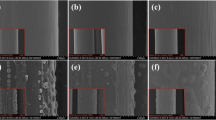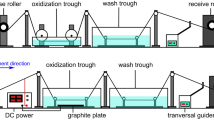Abstract
Carbon fiber-reinforced polymer composites (CFRPs) have many features, such as lightweight, high specific strength, and excellent chemical resistance. However, the adhesion at the interface of the CFRPs, which are composed of fiber and resin, is poor. Thus, de-lamination and interfacial peeling occur, and the mechanical properties, such as intrinsic strength and rigidity, decrease. Fiber surface modification by plasma and silane coupling treatments has attracted much attention to improve these properties. In this study, argon and oxygen mixed gas plasma treatment was used as pretreatment to introduce hydroxyl group on the fiber surface. This method was utilized to improve the adhesion between the fiber and resin. A silane coupling treatment was conducted to bond the carbon fiber and epoxy resin by chemical covalent bonding. The effect of silane coupling treatment on the interfacial property of CFRPs was investigated. Elemental analysis of the surface modified carbon fiber was explored through energy dispersive X-ray spectrometry. The functional groups of different carbon fiber surfaces were analyzed through X-ray photoelectron spectroscopy. The wettability of the treated carbon fiber was examined with a contact angle meter. The interlaminar shear strength was determined with a short beam method.
Similar content being viewed by others
References
H. Lee, C. Choi, J. Jin, M. Huh, S. Lee and K. Kang, Homog-enization-based multiscale analysis for equivalent mechanical properties of nonwoven carbon-fiber fabric composites, Journal of Mechanical Science and Technology, 33 (10) (2019) 4761–4770.
N. Dilsiz, N. K. Erinç, E. Bayramli and G. Akovali, Surface energy and mechanical properties of plasma-modified carbon fibers, Carbon, 33 (6) (1995) 853–858.
J. L. Thomason, The interface region in glass fibre-reinforced epoxy resin composites: 1. Sample preparation, void content and interfacial strength, Composites, 26 (7) (1995) 467–475.
A. Rezzoug, S. Abdi, A. Kaci and M. Yandouzi, Thermal spray metallisation of carbon fibre reinforced polymer composites: effect of top surface modification on coating adhesion and mechanical properties, Surface and Coatings Technology, 333 (2018) 13–23.
C. A. Charitidis, Electrochemical surface functionalization of carbon fibers for chemical affinity improvement with epoxy resins, Applied Surface Science, 416 (2017) 593–604.
X. Qian, X. F. Wang, Q. Ouyang, Y. Chen and Q. Yan, Effect of ammonium-salt solutions on the surface properties of carbon fibers in electrochemical anodic oxidation, Applied Surface Science, 259 (2012) 238–244.
Q. An, A. N. Rider and E. T. Thostenson, Hierarchical composite structures prepared by electrophoretic deposition of carbon nanotubes onto glass fibers, ACS Applied Materials and Interfaces, 5 (6) (2013) 2022–2032.
A. Feng, C. Lu, Y. Li, J. Guo, X. Lu, H. Lu, S. He and Y. Yu, Preparation and characterization of carbon nanotube-hybridized carbon fiber to reinforce epoxy composite, Materials and Design, 33 (2012) 197–202.
J. Shi, L. Bao, R. Kobayashi, J. Kato and K. Kemmochi, Reusing recycled fibers in high-value fiber-reinforced polymer composites: improving bending strength by surface cleaning, Composites Science and Technology, 72 (11) (2012) 1298–1303.
A. S. Tikhomirov, N. E. Sorokina and V. V. Avdeev, Surface modification of carbon fibers with nitric acid solutions, Inorganic Materials, 47 (6) (2011) 609–613.
B. Yu, Z. Y. Jiang, X. Z. Tang, C. Y. Yue and J. Yang, Enhanced interphase between epoxy matrix and carbon fiber with carbon nanotube-modified silane coating, Composites Science Technology, 99 (2014) 131–140.
Q. Wu, R. Zhao, Q. Liu, J. Tong, J. Zhu and F. Wang, Simultaneous improvement of interfacial strength and toughness between carbon fiber and epoxy by introducing amino functionalized ZrO2 on fiber surface, Materials and Design, 149 (2018) 15–24.
T. Sun, M. Li, S. Zhou, M. Liang, Y. Chen and H. Zou, Multi-scale structure construction of carbon fiber surface by electrophoretic deposition and electropolymerization to enhance the interfacial strength of epoxy resin composites, Applied Surface Science, 499 (2020) 143929.
X. Qian, Y. G. Zhang, W. X. Wang, Y. J. Heng and J. H. Zhi, Effect of carbon fibers surface functionality on the moisture absorption behavior of carbon fibers/epoxy resin composites, Surface and Interface Analysis, 48 (12) (2016) 1271–1277.
H. G. Tafti, P. Valipour and M. Mirjalili, Effects of corona treatment on morphology and properties of carbon based fillers/epoxy nanocomposites, Polymer Composites, 39 (S4) (2018) E2298–E2304.
J. Q. Li, Y. D. Huang, Z. W. Xu and Z. Wang, High-energy radiation technique treat on the surface of carbon fiber, Materials Chemistry and Physics, 94 (2–3) (2005) 315–321.
D. Xu, B. Liu, G. Zhang, S. Long, X. Wang and J. Yang, Effect of air plasma treatment on interfacial shear strength of carbon fiber-reinforced polyphenylene sulfide, High Performance Polymers, 28 (4) (2016) 411–424.
B. Wang, J. Li and Y. Gao, Enhancing hygrothermal resistance of aeronautical carbon fabric/epoxy composites via air plasma processing, Journal of Adhesion Science and Technology, 31 (5) (2017) 487–501.
H. Sun, J. Lee and M. S. Bak, Characterization of atmospheric electrodeless microwave plasma in nitrogen, Journal of Mechanical Science and Technology, 32 (2018) (12) 5999–6007.
K. Li, X. Zhou, G. Shi, S. Farhan and Z. Zhao, Microstructure and mechanical properties of carbon/carbon composites with PyC/SiC/TiC multilayer interphases, Ceramics International, 44 (2) (2018) 1964–1970.
Y. Jia, K. Li, L. Xue, J. Ren and S. Zhang, Internal friction behaviour of carbon fibre reinforced multilayered (PyC-SiC)n matrix composites, Composites Part B: Engineering, 114 (2017) 8–14.
J. Dong, J. He, C. Jia, Y. Song, Z. He, H. Wei, T. Zhang, W. Zheng, Z. Jiang and Y. Huang, Growth of carbon black onto continuous carbon fiber to produce composites with improved mechanical and interfacial properties: a step closer to industrial production, Composites Science and Technology, 173 (2019) 83–89.
S. J. Park and J. S. Jin, Effect of silane coupling agent on interphase and performance of glass fibers/unsaturated polyester composites, Journal of Colloid and Interface Science, 242 (1) (2001) 174–179.
P. Sae-oui, C. Sirisinha, U. Thepsuwan and K. Hatthapanit, Roles of silane coupling agents on properties of silica-filled polychloroprene, European Polymer Journal, 42 (3) (2006) 479–486.
J. M. He and Y. D. Huang, Effect of silane-coupling agents on interfacial properties of CF/PI composites, Journal of Applied Polymer Science, 106 (4) (2007) 2231–2237.
J. S. Yang, J. Y. Xiao, J. C. Zeng, L. P. Bian, C. Y. Peng and F. B. Yang, Matrix modification with silane coupling agent for carbon fiber reinforced epoxy composites, Fibers and Polymers, 14 (5) (2013) 759–766.
S. Jin, K. Kim and J. H. Jeong, Adhesion energy per unit area various liquid droplets on PMMA, Parylene C and PPFC coated flat solid surfaces, Journal of Mechanical Science and Technology, 33 (3) (2019) 1441–1450.
P. Zhu, B. Liu and L. Bao, Evaporation-induced surface coating of poly(p-phenylene benzobisoxazole) fibers with polyetherimide encapsulated nano-TiO2, Progress in Organic Coatings, 116 (2018) 43–50.
Acknowledgments
This work was supported by JSPS KAKENHI (Grant number JP17K14560), Japan.
Author information
Authors and Affiliations
Corresponding author
Additional information
Jian Shi is an Assistant Professor at the Department of Mechanical Engineering, Akita Prefectural University, Yurihonjo, Akita, Japan. He received his Dr. degree in Engineering from Shinshu University in Ueda, Nagano, Japan. His research interests include advanced fiber-reinforced polymer composites and functional nanomaterials for composites, biomaterials, and energy.
Rights and permissions
About this article
Cite this article
Shi, J., Yamamoto, Y., Mizuno, M. et al. Interfacial performance enhancement of carbon fiber/epoxy composites by a two-step surface treatment. J Mech Sci Technol 35, 91–97 (2021). https://doi.org/10.1007/s12206-020-1208-y
Received:
Revised:
Accepted:
Published:
Issue Date:
DOI: https://doi.org/10.1007/s12206-020-1208-y




